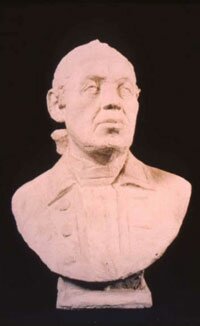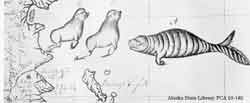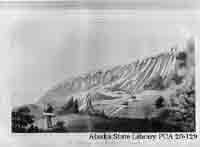|
Russia's Colony
More Russian Exploration in Alaska
The "discovery" of Alaska is usually dated from Bering's second expedition in 1741.
 Bust of Vitus Bering
Bust of Vitus Bering
Forensic reconstruction of explorer Vitus Bering. Reconstruction by V. N. Zvyagin, Institute of Forensic Medicine, Moscow. 1992-1995.
This is appropriate. The Alaska Native people at that time did not know the shape of North America or its relation to other continents. They did not have vessels capable of sailing great distances over the world's oceans and back to Alaska. In June 1741 Bering and his second-in-command, Aleksi Chirikov sailed in two ships from Kamchatka for North America. In mid July Chirikov sighted land southeast Alaska. Chirikov sent a boat ashore with a crew of eleven men to get fresh water and to look around. They did not come back. Six days later he sent a second boat with a crew of four to see what had happened to the first boat. This boat also vanished. A day later however, two boats paddled by Native people came out from where the Russian boats had gone. The Alaskans would not come very close to the St. Paul, and after shouting a message, they paddled back to where they had come from. No record exists of the fate of the Russian sailors who disappeared. Disappointed, Chirikov sailed back to Kamchatka.

Steller's sea cow
Collection Name: Alaska Historical Library, Alaska Centennial Collection.
In the meantime, Bering anchored off an island farther north, near Cape St. Elias. Georg Steller, the expedition's naturalist, spent a number of hours on the island and recorded observations of plants, crustaceans and sea shells, and detailed evidence of Native people and how they lived, even though he did not actually see any Native people. Natives apparently used the island for fishing and hunting sea mammals, but lived elsewhere.
Bering set sail for Kamchatka after only a day on the North American coast. He was low on supplies and his men were beginning to suffer from scurvy. Heading west they passed a number of islands, and anchored in the Shumagins, which they named for a sailor who died on board. From one of the islands two kayaks approached the ship and the Russians and Alaskans exchanged goods. The Natives invited the Russians ashore, and ten men ventured onto the island where they met with nine Aleuts. When the Russians prepared to leave the Aleuts tried to hold one back. He wrestled free and swam to the departing boat while the Russians fired their muskets into the air. The next day nine Aleuts paddled to the St. Peter and exchanged more goods. The following day the Russians sailed on. This was the first recorded, direct encounter between Europeans and Alaska Natives.
Links:
- Vitus Bering
- Georg Steller
- Georg Steller
- Steller's sea cow
- Sven Waxell

Petropavlovsk, 1741
Collection Name: Alaska Historical Library, Alaska Centennial Collection.
Bering's ship was ill-fated. Many of the crew had scurvy, and soon there were not enough healthy men to man the sails. On the 4th of November they sighted land and decided to run into a small bay. They hoped they were on the Kamchatka coast, but they were actually on an island that was 115 miles away. The ship ran aground in shallow water. Those who could carried the sick men ashore. Several days later a storm wrecked the vessel leaving them marooned. On December 8, 1741 Captain-Commander Bering died. Others died daily as they struggled against scurvy and the elements. Forty-five of the original crew of seventy-six survived the ordeal, and in the spring and summer built a small boat from the wreckage of their old vessel and sailed for Kamchatka. They arrived at Petropavlovsk in August.

Petropavlovsk, 1769
Collection Name: Alaska Historical Library, Alaska Centennial Collection.
Over the next one hundred years the Russians would learn a great deal about the geography of the North Pacific and Alaska. There would be over sixty Russian voyages to what they called Russian America before its sale to the United States in 1867. The explorers mapped the Bering Sea coast and some of the Arctic.

Kotzebue Sound, 1816
Collection Name: Alaska Historical Library, Alaska Centennial Collection.
They gathered important data about the Native people, animals and plants, climate, the ebb and flow of the annual winter ice pack, and the resources of the sea and land, including marine and land fur-bearing mammals and minerals. Their knowledge contributed substantially to world geographical understanding, and to Alaska's important role in the north.
Links:
- Russian Ocean Expeditions
- Russia's Arctic Explorations
|


